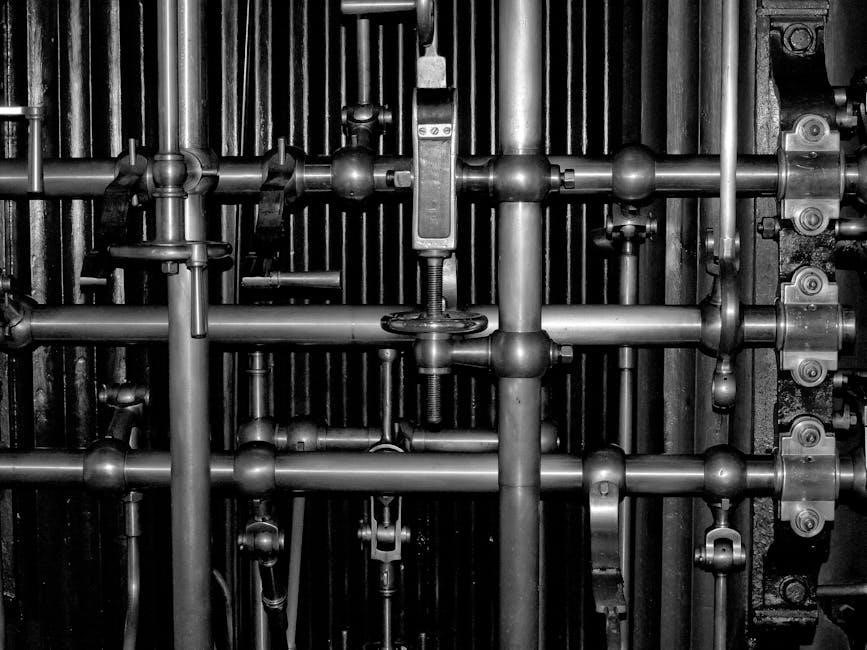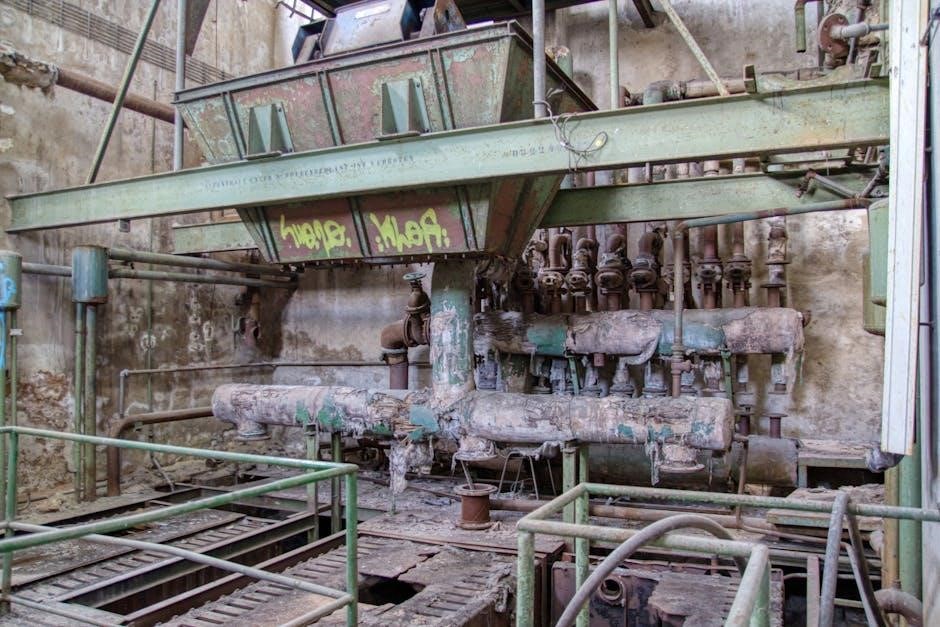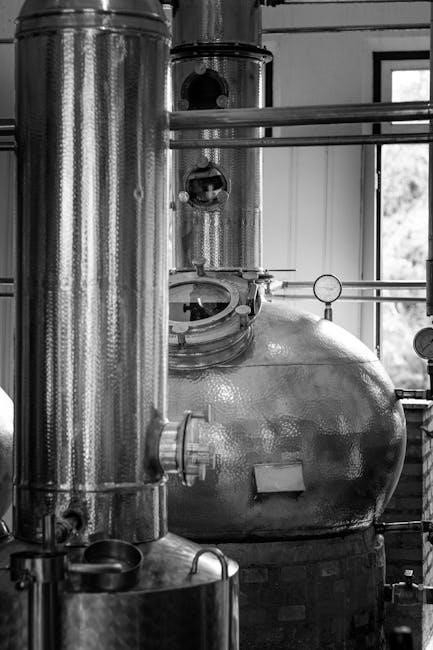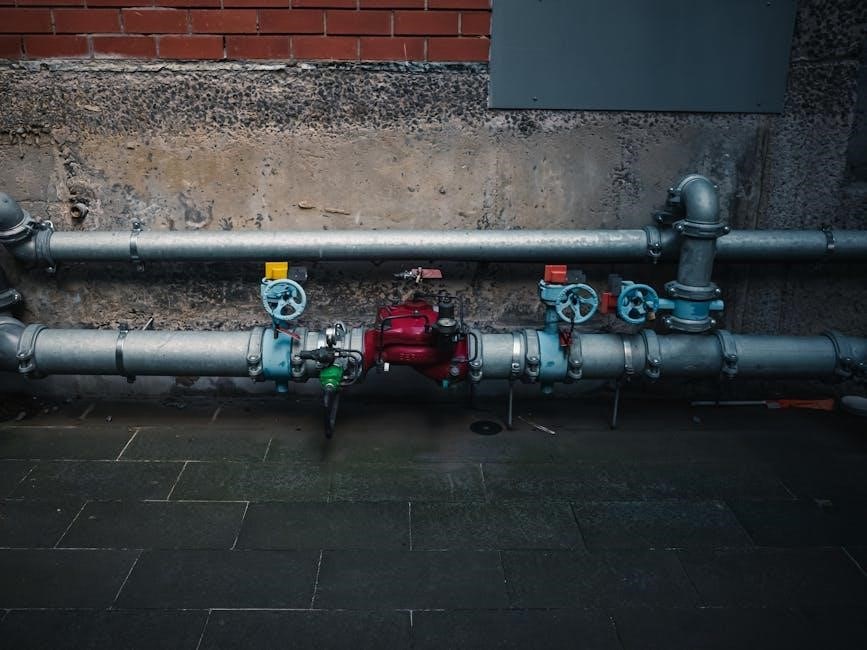Engine valves and guides are critical components in internal combustion engines, controlling airflow and ensuring proper combustion. Valves regulate intake and exhaust processes, while guides support their smooth operation, maintaining engine efficiency and reliability. Properly functioning valves and guides are essential for optimal performance and longevity of the engine.
1.1 Overview of Engine Valves
Engine valves are cylindrical components that regulate airflow in internal combustion engines. They control the intake of air-fuel mixture and exhaust gases, ensuring proper combustion. Typically, engines have intake and exhaust valves, operated by cams and lifters. Valves are crucial for maintaining engine performance, efficiency, and longevity. They are designed to withstand high temperatures and pressures, making them essential for smooth engine operation. Properly functioning valves prevent damage and ensure optimal power delivery, playing a vital role in the engine’s overall functionality and reliability.
1.2 Importance of Valve Guides in Engine Functionality
Valve guides are cylindrical bushings pressed into engine cylinder heads, ensuring precise alignment and movement of valve stems. They prevent side-to-side motion, reducing wear and tear on valves and engine components. Guides maintain proper valve sealing, preventing oil leakage and combustion gases from escaping. This enhances engine efficiency, reduces emissions, and prevents overheating. Durable materials like cast iron or bronze are used for longevity. Properly functioning valve guides are essential for maintaining engine performance, reliability, and overall operational efficiency, making them a critical component in modern internal combustion engines.

Types of Engine Valves
Engine valves include intake, exhaust, and special-purpose valves. Intake valves admit air-fuel mixture, while exhaust valves expel combustion gases. Special-purpose valves serve specific functions like turbocharging or variable timing.
2.1 Intake Valves
Intake valves are responsible for admitting the air-fuel mixture into the engine’s cylinders. They play a critical role in ensuring proper combustion by allowing the correct amount of air to enter. Their design and operation are tailored to meet the engine’s specific requirements, contributing to efficient combustion and optimal engine performance. Properly functioning intake valves are essential for maintaining fuel efficiency, reducing emissions, and ensuring smooth engine operation under various driving conditions.
2.2 Exhaust Valves
Exhaust valves are responsible for expelling combustion gases from the engine’s cylinders. They open after the power stroke, allowing spent gases to exit into the exhaust system. Properly functioning exhaust valves ensure efficient engine operation by preventing gas buildup and maintaining optimal performance. Their design and materials must withstand high temperatures and corrosive environments. Faulty exhaust valves can lead to reduced engine efficiency, increased emissions, and potential damage to the catalytic converter. Regular maintenance is crucial to ensure they operate smoothly and reliably over time.
2.3 Special Purpose Valves
Special purpose valves are designed for unique engine requirements, such as turbocharged engines or variable valve timing systems. These valves often feature advanced materials and designs to handle high-pressure and high-temperature environments. They may include components like tumbling valves or swirl control valves, which enhance combustion efficiency. Special purpose valves are crucial for optimizing engine performance, fuel efficiency, and emissions reduction in modern engines. Their precise engineering ensures reliability under extreme operating conditions, making them indispensable in high-performance and specialized engine applications.
The Role of Valve Guides
Valve guides ensure proper alignment and smooth operation of engine valves, preventing wear and tear. They support the valve stem, maintaining precision and reducing friction during operation, which is crucial for engine performance and longevity. Guides also help in heat dissipation, contributing to overall engine efficiency and reliability. Their role is vital for maintaining optimal engine function under various operating conditions.
3.1 Function of Valve Guides
Valve guides are cylindrical components in an engine’s cylinder head that support the valve stem, ensuring precise alignment and smooth movement. Their primary function is to guide the valve as it opens and closes, maintaining proper sealing and preventing wear. Guides also act as heat sinks, dissipating heat from the valve to the cylinder head, which helps maintain optimal engine temperature. Properly functioning valve guides are essential for efficient combustion, reduced friction, and overall engine performance. They play a critical role in ensuring the engine operates smoothly under various conditions.
3.2 Importance of Proper Valve Guide Alignment
Proper valve guide alignment is crucial for ensuring efficient engine operation. Misalignment can lead to increased wear on valve stems and guides, reducing engine performance. Correct alignment ensures valves seal properly, maintaining compression and preventing leaks. It also minimizes friction, reducing heat buildup and potential damage. Properly aligned guides contribute to smoother engine operation, better fuel efficiency, and reduced emissions. Misalignment can lead to premature wear, increased maintenance costs, and potential engine failure. Accurate guide alignment is essential for optimal engine durability and performance.
Materials Used for Valves and Guides
Valves and guides are made from durable materials like stainless steel, high-temperature alloys, and manganese bronze. These materials ensure longevity, heat resistance, and optimal engine performance.
4.1 Common Materials for Valves
Engine valves are typically made from high-strength, heat-resistant materials such as stainless steel, titanium, and high-temperature alloys. These materials are chosen for their durability and ability to withstand extreme engine conditions. Stainless steel is widely used due to its resistance to corrosion and wear. Titanium offers excellent strength-to-weight ratio, ideal for high-performance engines. High-temperature alloys, like Inconel, are used in exhaust valves to handle high exhaust gas temperatures. Proper material selection ensures reliable valve operation and longevity.
4.2 Durable Materials for Valve Guides
Valve guides are typically made from durable materials like cast iron, manganese bronze, or hardened steel. These materials offer excellent thermal conductivity and resistance to wear, ensuring longevity. Bronze guides provide superior lubricity, reducing friction between the valve stem and guide. In high-performance engines, advanced coatings or hardened surfaces are applied to enhance durability. Proper material selection for valve guides is crucial to maintain engine efficiency, prevent premature wear, and ensure smooth valve operation over time.

Maintenance and Replacement of Valves and Guides
Regular maintenance ensures optimal engine performance. Cleaning and inspecting valve guides prevent wear, while replacement is necessary when guides show visible damage or performance issues arise.
5.1 Cleaning and Servicing Valve Guides
Cleaning and servicing valve guides are essential for maintaining engine performance. Use specialized tools to remove carbon buildup and debris. Apply cleaning solvents or high-pressure washes to ensure thoroughness. Avoid abrasive materials that could damage the guides. After cleaning, inspect for wear or damage. If guides are worn, replacement may be necessary. Proper servicing ensures valve guides remain functional, maintaining proper valve alignment and preventing engine issues like reduced performance or increased emissions. Regular maintenance extends the lifespan of both valves and guides.
5.2 When to Replace Worn Valve Guides
Replace valve guides when excessive wear is detected, such as increased oil consumption or engine smoke. Worn guides cause valve misalignment, leading to poor engine performance and potential damage. If guide clearances exceed specifications, replacement is necessary. Symptoms like reduced power, rough idling, or increased emissions indicate worn guides. Inspect during regular maintenance to prevent severe engine issues. Timely replacement ensures proper valve function, maintains engine efficiency, and avoids costly repairs. Always use high-quality materials to ensure durability and reliability.
Leading Manufacturers of Valves and Guides
Prominent brands like IVAM and Goodsons specialize in producing high-quality engine valves and guides. These manufacturers focus on durability, precision engineering, and meeting industry standards for optimal performance.
6.1 Prominent Brands in the Industry
Leading manufacturers like IVAM and Goodsons are renowned for producing high-quality engine valves and guides. IVAM specializes in durable components for gas and diesel engines, catering to cars, trucks, and industrial machinery. Goodsons offers a wide range of valve guides in materials like cast iron and manganese bronze, ensuring precise fitment and reliability. These brands prioritize innovation and adherence to strict quality standards, making them trusted names in the automotive and engineering sectors.
6.2 Quality Standards in Manufacturing
Manufacturers adhere to stringent quality standards to ensure valves and guides meet performance and durability expectations. Processes include precise machining, material selection, and rigorous testing. Standards often involve dimensional accuracy and resistance to wear and tear. This commitment ensures components function reliably under various engine conditions, maintaining efficiency and longevity. Quality control measures are integral to producing parts that meet industry benchmarks and customer demands, fostering trust and reliability in the automotive and engineering industries.
Common Issues with Valves and Guides
Worn valve guides can cause oil leakage and reduced engine performance. Excessive redlining may lead to valve float and overheating, potentially damaging engine components over time.
7.1 Signs of Worn Valve Guides
Worn valve guides often exhibit symptoms such as excessive oil consumption, smoke from the exhaust, and decreased engine performance. Increased clearance between the valve stem and guide can lead to engine misfires and reduced power output. Over time, this wear may cause the valve to move improperly, potentially damaging the cylinder head. Regular inspection is crucial to identify these issues early, preventing costly repairs and ensuring optimal engine functionality.
7.2 Effects of Improper Valve Timing
Improper valve timing disrupts the engine’s combustion process, leading to reduced performance, lower fuel efficiency, and increased emissions. Misaligned timing can cause valves to open or close incorrectly, potentially damaging pistons or cylinder walls. This misalignment often results in poor engine idle, rough running, and decreased power output. In severe cases, it can cause engine overheating or valve float, leading to costly repairs. Maintaining precise valve timing is crucial for optimal engine operation and longevity. Regular checks and adjustments are essential to prevent these issues.

Future Trends in Valve and Guide Technology
Advancements in material science and innovative designs aim to enhance efficiency, reduce emissions, and improve durability in engine valves and guides.
8.1 Advancements in Material Science
Recent advancements in material science have led to the development of lightweight, high-temperature-resistant alloys for engine valves and guides; These materials improve durability and reduce wear, enhancing engine performance. Researchers are also exploring the use of ceramic coatings and self-lubricating surfaces to minimize friction and extend component lifespan. Additionally, 3D printing technologies are being utilized to create complex valve geometries, offering improved flow dynamics. These innovations aim to increase fuel efficiency, reduce emissions, and maintain reliability in modern engines.
8.2 innovations for Improved Efficiency

8.2 Innovations for Improved Efficiency
Modern innovations are focusing on improving valve and guide efficiency through advanced technologies. Variable valve timing systems, like VVT-i, optimize engine performance by adjusting timing for better torque and fuel economy. Additionally, lightweight materials and coatings reduce friction, enhancing efficiency. Innovations in valve design, such as hydraulic lash adjusters, minimize mechanical wear and maintain precise control. These advancements aim to reduce emissions while increasing power output, ensuring engines operate smoothly across a wide range of conditions. Real-time adjustments and sensor-integrated systems further enhance efficiency and reliability.
